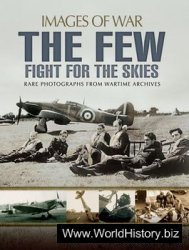Terror bombing see bombing.
Teruel, Battle of (December 1937-February 1938), Spanish Civil War. In late 1937 the Republican high command discovered that Franco was planning to attack Madrid again from the Guadalajara front. This sector was reinforced and an assault on the Nationalists’ left flank hurriedly prepared. Teruel was attacked on December 15 with nearly 100,000 men including reserves, but soon suffered the fete of previous Republican offensives. After a rapid initial success, which in this case achieved the objective of spoiling Franco’s plan, the Republic’s exaggerated propaganda claims prevented withdrawal. The casualties sustained from heavy fighting and the appalling winter conditions led to the gradual disintegration of Republican units under the Nationalist counterattacks. A complete rout followed in mid-February after a surprise flank attack by Carlist and Legion formations near Alfambra prepared the ground for the Aragon offensive. AB.
Test Ban Treaty. In 1963 the USA, USSR and UK signed a treaty banning nuclear tests in the atmosphere, underwater and in outer space. This was one of the first steps to an improvement in superpower relations following the Cuban missile crisis, but the arms-control effect was limited. France and China did not sign, and continued for a time to test in the atmosphere while the signatories began to use underground tests not banned — because of verification problems. During the 1970s the superpowers agreed on a threshold test ban of 150 kilotons but this was never verified and talks on a comprehensive test ban also proved abortive. The Reagan administration regarded testing as an essential part of the maintenance of nuclear forces while the British argued that a comprehensive test ban was still unverifiable. The superpowers are currently discussing ways of implementing the threshold ban. EJG.
Tet offensive (1968). The turning point of the Vietnam War. Tet is the Vietnamese New Year, and over half of all South Vietnamese
Troops were on leave when communist forces, on January 30-31, launched a “general offensive and uprising” with attacks on 5 major cities, 36 province capitals and 64 district seats. Some 84,000 communist troops had assembled on city outskirts, yet the assault forces achieved almost complete surprise. Sappers penetrated the US embassy in Saigon and attacked the presidential palace and South Vietnamese general staff headquarters. In one blow the communists proved that they still held the strategic initiative and could strike at will in “secure” areas.
The offensive actually began not in the cities but with diversionary attacks in the highlands and at Khe Sanh. In the cities. South Vietnamese and US troops hastily regrouped to beat off the attacks in a few days. The popular uprisings anticipated by the communists mostly failed to materialize, as frightened civilians stayed indoors. The exception was at Hue, where the assault force, one of the few that consisted largely of North Vietnamese regulars, held out until February 24. Two more “violent surges”, much weaker than the first, occurred in May and August.
Contrary to popular belief that the communists’ aim was to affect American domestic opinion, their principal strategic aims were to improve their battlefield position and alter American leaders’ assessments of the war’s cost. With the war in stalemate, the communists sought to shatter American confidence by demonstrating their ability to attack when and where they pleased. At a maximum they hoped to so weaken South Vietnam’s administration and army that a coalition including the National Liberation Front or its sympathizers could take its place. This new government, they calculated, would then sue for peace and demand American withdrawal. At a minimum they expected to jar the war into a new phase, leading to negotiations.
The attacks were extremely costly to the communists, who lost up to 40,000 dead, compared with 2,300 South Vietnamese and 1,100 Americans. The Americans and South Vietnamese used the opportunity to push “pacification” into areas long under communist control. However, in the US the offensive demolished the official optimism and strengthened opposition. The change persuaded President Johnson to announce he would not seek re-election and to call for peace talks. WST.
“Texas”/“Lien Kiet 28” Operation. An attack on March 19 1966 by the flap 1st Regiment on a South Vietnamese Regional Force outpost just south of the US Marine base at Chu Lai triggered Operation “Texas”, or “Lien Kiet 28” to the Vietnamese. A joint Marine/South Vietnamese force relieved the outpost, then intercepted and inflicted over 600 casualties on the withdrawing
FLAP.
Texas. US battleship. New York-class,. Completed 1914, with Grand Fleet 1918. Bombardment duties at the “Torch”, Normandy, South of France, Iwo Jima and Okinawa landings.
Theatre nuclear weapon. A nonstrategic weapon designed for use in the context of military operations in a particular Eurasian theatre; the perspective of judgment is that of the superpowers. Theatre weapons cover both bat-tlefield/tactical systems and intermediate forces. The dividing line with “strategic” forces is not rigid. The USA allocates some SLBMS to the theatre role, while the USSR does the same with both SLBMS and variable range icbms.
Thermonuclear weapon, A
Second-generation nuclear weapon, or “hydrogen bomb” in which a fission “primary” (often itself “boosted”) provides the X-radiation to form a plasma which compresses a cylinder of thermonuclear material, usually a chemical compound of lithium and heavy hydrogen (deuterium). In the centre of the cylinder is a uranium “spark plug” that begins to fission due to radiation coupling with the primary. Neutrons from this reaction cause the lithium to transform into tritium, another isotope of hydrogen, which fuses with the deuterium at very high temperature, creating helium and enormous energy. The thermonuclear reaction provides the heat to sustain itself after being “ignited”.

The casing of the cylinder is usually made of uranium-238 which fissions when bombarded by the high speed neutrons produced by fusion. The reaction can be passed on to another thermonuclear cylinder to increase the yield further. Enhanced radiation weapons employ an alternative design to optimize high-speed neutron production at very low yields. The yield of a normal fission-fusion-fission thermonuclear weapon is theoretically limitless; the largest test was a Soviet 57 megaton device but most modern weapons are in the high kiloton range. EJG.
Thetis. British warships. (1) Old Apollo-cass second-class cruiser sunk as a blockship in the unsuccessful attempt to block Zeebrugge (April 23-24 1918). (2) T-class submarine lost on her trials in 1939, raised, renamed Thunderbolt and lost in action 1943.
Thiepval. Fortified village on a plateau at the northwestern end of the Pozieres Ridge. Flanked by the Schwaben and Leipzig Redoubts, it was one of the strongest German defensive positions on the Somme in 1916. Fell to the British 18th Division on September 26 1916, although the Schwaben Redoubt was not finally cleared by the 39th Division until October 14.
Thiepval Wood. Front line and assembly area of 36th (Ulster) Division, Somme, July 1 1916.
Thieu, Gen Nguyen Van (b. l923). Republic of Vietnam. In 1945, Thieu entered the French-run military academy at Dalat, received further training in France, and emerged from the Indochina War a battalion commander. A convert to Catholicism under the Catholic regime of Ngo Dinh Diem, he commanded the troops that surrounded Diem’s palace in November 1963. Adroit manoeuvring within the juntas that governed after Diem was ousted brought Thieu to the presidency in
1967.
Thieu consolidated personal power by manipulating the factional quarrels and corrupt practices of military and civilian officials alike. That ability earned him the support of the US, which prized political stability. However, he was not a broadly popular figure. He instituted the Land-to-the-Tiller reform in 1970, partly to create a base of support for himself before the Americans withdrew. Torn between duty to country and dependency on the US, Thieu felt abandoned by the American failure to save his regime, resigned on April 25 1975, and exiled himself to Britain. WST.
Third Army (US). One of the follow-up units during the invasion of France. Commanded by Patton, it led the breakout from the Normandy bridgehead and rapidly swept through France. It further distinguished itself in the Ardennes and the advance into Germany and Czechoslovakia.
Third Fleet (US). Established March 1943, replacing the South Pacific Force. Later in the war, the designation of the main Pacific Fleet was the Third Fleet, when Adm Halsey commanded and Spruance was planning the next operation, and Fifth Fleet when the situation was reversed. Postwar, this is the number of the Eastern Pacific fleet.
Third Reich. Designation of Hitler’s regime of 1933 — 45, succeeding Charlemagne’s (first) and Bismarck’s (second) empires.
Thirteenth Air Force (US). Activated in January 1943. Served in the South and Southwest Pacific, supporting the Allied advance from the Solomons to the Philippines. Its heavy and medium bombers also attacked Japanese installations at Truk, Formosa, French Indochina and Borneo.
Thirty-Eighth Parallel. Selected by Col Bonsteel and Col Rusk on the night of August 10—11 1945 as the dividing line between the Soviet and US zones of occupation in Korea. The choice was reached on the basis of a small-scale map and the Parallel was picked as the most obvious line of demarcation which would leave the Korean capital, Seoul, in US hands. The division was meant to be temporary but as the Cold War gathered momentum, it developed into a permanent dividing line. The 38th Parallel became the boundary between the opposing Korean states founded in 1948 but was recognized by neither as an international frontier. It was the North Korean decision to cross the Parallel in June 1950 which provoked armed intervention by the un. When truce talks began in July 1951, the communist side proposed the ending of hostilities on the basis of the 38th Parallel. The un command insisted on the more, favourable line of military contact and the armistice was concluded on this basis. CM.
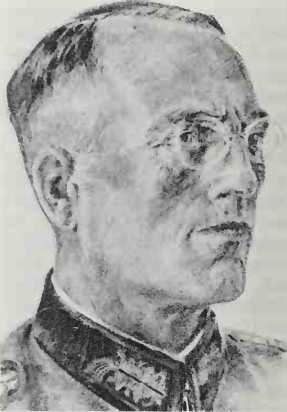
Von Thoma; armoured warfare expert
Thoma, Lt Gen (General der Pan-zertruppen) Wilhelm Ritter von
(1891—1948). Ger. One of the architects of German armoured warfare doctrine in the 1930s. Thoma commanded the ground forces of the Condor Legion in Spain, 1936-39. He commanded a panzer brigade in Poland, 1939, and in 1940, after observing Graziani’s preparations for the Cyrenaica offensive, submitted a prescient report on the difficulties inherent in a major German commitment in North Africa. Nevertheless, in September 1942, following a corps command in Russia, he succeeded Nehring as commander, Afrika Korps. On October 24—25 1942, at El Alamein, between Stumme’s death and Rommel’s hasty return from sick leave, Thoma was briefly c-in-c, Panzerarmee Afrika. When Rommel’s withdrawal plan was overruled by Hitler, Thoma launched an abortive counterattack; he was captured on November 4 while attempting to stem the breakout by Montgomery’s X Corps. RO’N.
Thompson, Sir Robert G K
(b. l916). Br. Served in various capacities in Malaya, including Secretary for Defence, 1959-61, before heading a British advisory mission to South Vietnam, 196165. He advised the South Vietnamese and the Americans to apply the lessons from the successful British counterinsurgency in Malaya, of which the core concept was denial of enemy access to the people. While the Americans ignored Thompson’s caution against excessive military force, the Vietnamese too eagerly applied his concept of strategic hamlets, in disregard of crucial differences between Malaya and Vietnam. See also strategic hamlet
PROGRAM.
“Thor” (“Karl”). German 60cm self-propelled howitzer, of the type used during the siege of Sevastopol, 1942. Only six of these weapons were built.
“Thousand-Bomber raid” see
COLOGNE.
Throw-weight. This is the weight a ballistic missile can carry over its notional range in its normally planned trajectory. As well as the “payload” of warheads, it includes the post-boost vehicle and the inertial guidance package. Historically, Soviet icBMs have had large throw-weights with “heavy” missiles like the SS-6, 9 and 18 in the 8,800-15,9501b (4,000-7,250kg)
Class and “medium” missiles like SS-17, 19 and 25 in the 6,600-7,700ib (3,000-3,500kg) class. The MX Peacekeeper is in the latter category, but the throw-weight of “lightweight” missiles like Minute-man is only 1,535-2,2001b (7251,000kg). The higher the throw-weight, the larger the number and yield of the warheads and the greater the mirv “footprint”. A major aim of American arms control policy has been to even up the throw-weight balance. The higher the throw-weight the greater the counter-force potential. EJG.
Thunderbolt see p-47.
Tibbets, Col Paul W, Jr (b. l915). US. Pilot of the B-29 Enola Gay which dropped the first atomic bomb on the Japanese city of Hiroshima, August 6 1945.
Tiger. German PzKw VI (56 tons). Introduced 1942 as answer to Russian T-34 and the heavier JS and KV tanks. Improved version with contoured armour on turret, “King Tiger” (65 tons) introduced 1944. Both carried 88mm gun. See also
TANKS.
“Tiger” convoy (May 5-12 1941). Ordered by Churchill to carry urgently needed tanks for Gen Wavell’s offensive in the Western Desert. Run successfully through the Mediterranean with the loss of only one merchantman.
Tiger Moth, de Havilland DH.
82A (Br, pre-WWII and after). Two-seat elementary trainer. Prototype flew October 26 1931. Built in quantity and widely exported before World War II; production Canada began 1937, also built Norway, Sweden, Portugal. Many built during war, used British Commonwealth Air Training Plan; further production Australia, New Zealand, and DH82C Canada. After Dunkirk, some fitted with bomb racks for antisubmarine patrols. Production, 8,280. One 130hp de Havilland Gipsy Major engine; max. speed 104mph (166kph); 1601b (72kg) bombs.
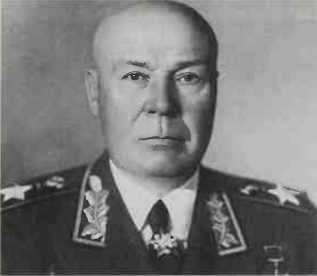
Timoshenko: defended Moscow
Timoshenko, Marshal Semyon
(1895-1970). Russian. Timoshenko served briefly in the Imperial Russian Cavalry during World War I before joining the Red Army in 1918. He fought throughout the Civil War and by the end of hostilities was in command of the Fourth Cavalry Division. An associate of Stalin’s, he was untouched by the purges of the Red Army and, in September 1939 he was given the task of leading the forces of the Ukrainian Front against Poland’s unprotected eastern frontier. Later in the year, as commander of the Northwestern Front, Timoshenko tried to break the strong Finnish defences on the Karelian Pensin-sula. Although ultimately victorious, the war against Finland had thrown up many glaring deficiencies in the Red Army and in May 1940 Timoshenko was appointed People’s Commissar for Defence with orders to improve the situation. His reforms barely had time to show any effect before the German invasion of June 1941 put the Red Army to the test. On July 2 Timoshenko took command of the Western Front, which was, in effect, the centre of the Soviet line. In a long and costly battle centred on Smolensk, Timoshenko blocked the German advance on Moscow for two months. This relative success led to his being appointed commander of the Southwest Front in order to try and save something out of the disaster left by Budenny in Kiev. Timoshenko managed to achieve some stabilization of the front but his own offensive in May 1942 was soon checked and formed a prelude to a crushingly successful German advance. The penalty for his failure was dismissal and in July he was recalled to Moscow. He was given one more brief period of command with the Northwestern Front but his major contribution for the remainder of the war was staff and planning duties at Stavka. MS.
Tiran, Straits of see suez crisis.
Tirpitz, Grand Adm Alfred von
(1849-1930). Ger. Secretary of State of the German Imperial Navy 1897-1916. Throughout the years of the Anglo-German naval race and, in particular, after the British introduction of the Dreadnought class in 1906, Tirpitz was the dominant naval figure in Germany. His building of a first-class German fleet of modern ships, which by 1914 posed a serious threat to Britain’s Grand Fleet, was an achievement without parallel in the history of naval construction and innovation. His political judgment that Britain, France and Russia would be unable to form an alliance proved for Germany to be disastrously wrong, nor does he seem to have anticipated the Anglo-Japanese alliance

Which enabled Britain to concentrate the greater part of her naval strength in European waters. His frustration at the extent to which, after these developments, the Grand Fleet was able to neutralize the High Seas Fleet unhinged his strategic judgment. He resigned before the Battle of Jutland was joined and became an advocate of unrestricted submarine warfare. ANF.
Tirpitz. German battleship. Nearly
42,000 tons displacement increasing to over 52,000 when fuelled and armed. Eight 15in guns. Powerful secondary armament.
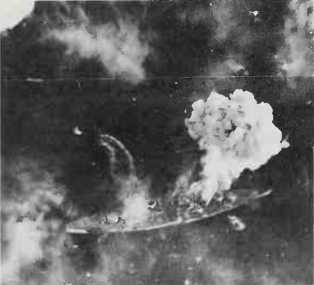
Fleet Air Arm bombers strike Tirpitz
Maximum speed 31 knots. Range
8,000 miles G3,000km). Mostly in port and only fired her main armament in anger once at Spitzbergen in September 1943. Nevertheless, her threat was a major factor in tying down Allied naval forces and absorbing air effort. The false rumour that she was putting to sea in July 1942 led to the disaster of convoy PQ 17. Repeatedly attacked by the British Fleet Air Arm, Bomber Command and Russian bombers. Seriously damaged by British midget submarines, for which Lt B C G Place and Lt D Cameron were awarded the vc. Direct hits from Lancasters of Bomber Command on November 12 1944 caused her to capsize and become a total wreck. Of her complement of 1,900,1,000 were killed or injured. ANF.
Titan missile. Large American liquid-fuelled iCBM. Titan 1, in service 1962-66, had to be fuelled before launch and was deployed in silos from which it was hoisted to fire. The improved Titan 2, first deployed in 1963, had fully stor
Able propellant and was fired inside its silo. Fifty-four were retained into the 1980s to provide a high-yield strike capability. The missile could send a 9 megaton warhead 9,000 miles (15,000km) with a CEP of about 3,280ft (1,000m). The last were withdrawn in 1987. •
Tito, President Josip (18921980). Yugoslavian. Born in Croatia, Josip Broz, later known as Tito, served in the Austro-Hungarian army during World War I. He was wounded and taken prisoner by the Russians in April 1915 but escaped from captivity in 1917 and took part in the Bolshevik seizure of power. After fighting against the White Russian forces he returned to Croatia in 1920 where he worked in an iron foundry while becoming increasingly involved in the illegal communist party. This led to his arrest and several years’ imprisonment. On his release he made frequent trips to the Soviet Union and, in 1937, became General Secretary of the Yugoslav Communist Party. He denounced World War II as an “imperialist” struggle but with the German invasion of Yugoslavia in April 1941 and the subsequent attack on the Soviet Union, his attitude changed. Adopting the
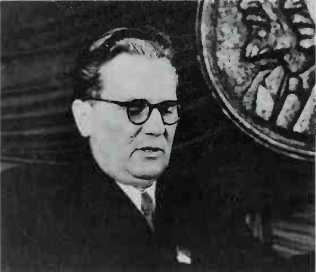
Tito: Yugoslav partisan chief
Nom de guerre of “Tito”, he was sent to Belgrade by the Comintern to organize resistance and in August transferred his centre of operations to Serbia. He was soon in control of large areas of the region but his relations with Mihailovich, the other main Yugoslavian resistance leader was decidedly antagonistic. Negotiations between Tito’s Partisans and Mihailovich’s Chet-niks soon broke down and armed clashes occurred between the two groups. A German counteroffensive in December 1941 forced Tito to retreat into Bosnia and Montenegro but he was a master of guerrilla warfare and had sufficiently recovered his fortunes in November 1942 to capture Binac. Tito’s standing with the Allies steadily increased and he received substantial supplies of arms and equipment, in addition to political recognition that led to summit talks with Churchill and Stalin. Surviving determined German anti-partisan operations in 194344, Tito’s Partisans linked up with Soviet ground forces in October 1944 and made a substantial contribution to the liberation of their country. Tito’s military, political and diplomatic skills ensured his ultimate victory both over the Axis and his own political opponents. In the postwar settlements he won important concessions for Yugoslavia and, significantly, managed to retain his independence from Stalin. In June 1953 Tito became President of Yugoslavia, a position he retained until his death in 1980. MS.
Tizard, Sir Henry Thomas (18851959). Br. Architect of the British radar defence system in the Battle of Britain. Tizard was conservative by nature and taste but radical in thought and action. As a physical chemist, he was employed on experimental flying in the rfc in World War I and then became, as he later put it himself, a scientist in and out of the civil service. After Hitler came to power and Britain gradually began to look to her defences, the most serious threat was from the revived Luftwaffe. No system of air defence would avail unless early warning of the approach of hostile bombers could be obtained. For a solution, the Air Ministry turned to Tizard. He recognized the relevance of Watson-Watt’s radio echo system for tracking clouds. In the face of opposition and scepticism, Tizard drove this idea through as a means of detecting enemy bombers and obtained the resources for a chain of radar stations along the coasts of Britain. He won the confidence of the c-in-c. Fighter Command so that theoretical ideas could be tested and adapted to meet flying capacities. The result was that, when the Luftwaffe attack came in 1940, the




 World History
World History



